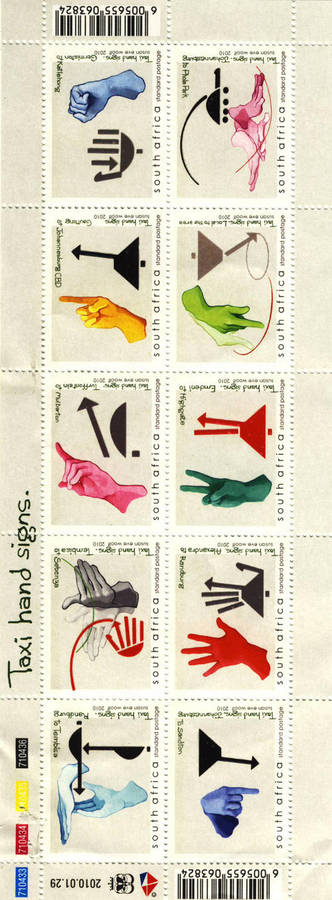
South African 2010 TAXI SIGNS SPECIAL EDITION STAMPS
Check my rate
| Main centres: | 1-3 business days |
| Regional areas: | 3-4 business days |
| Remote areas: | 3-5 business days |

| Main centres: | 1-3 business days |
| Regional areas: | 3-4 business days |
| Remote areas: | 3-5 business days |
Taxi hand signs have been dubbed South Africa’s “12th official language”. Millions of South African commuters use this unspoken, unwritten language every day to communicate to taxi drivers where they want to go. Developed and adapted over the years, these hand signs are unique to South Africa.
Each hand sign indicates a specific route. Current information documented covers 80% of taxi routes with, currently, 28 major hand signs for the Gauteng area alone. The intention is to eventually also cover the rest of South Africa.
To make these signs accessible to blind and partially blind people, a separate set of taxi hand signs were designed for the blind, in collaboration with the South African Blind Workers Association (SABWA).
The stamps depict a set of ten symbols developed for blind and partially sighted people. These symbols represent all the taxi hand signals and include raised symbols accessible to blind and partially sighted people.
The stamps were designed by artist Susan Woolf, who after two years of research published a booklet on taxi hand signs for blind and sighted people and is currently working on this as a major arts project for a PhD in Anthropology and Art at Wits University. She plans an art exhibition on that subject in Johannesburg 2010.
Soil from Soshanguve’s Philadelfia School for children with special needs is used in the printing process of the stamps. It was applied to the stamps using a UV lacquer suitable for soil and was applied to the stamps using a silk screen process. This results in the signs being raised and thus making it possible for a blind person to feel the taxi sign.
